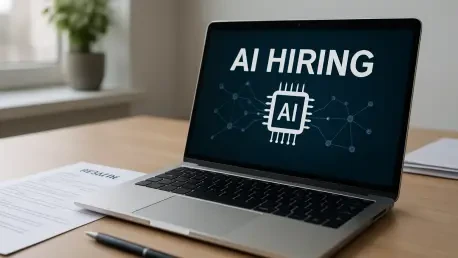In an era where remote hiring has become the norm, a troubling trend has emerged that poses significant challenges for human resources professionals across industries, as malicious actors are leveraging advanced technologies like generative AI, deepfake videos, and stolen personal data to create fraudulent job applications. These sophisticated schemes flood the market with fake candidates and are not just a minor inconvenience but a serious threat to organizational security, often aiming to infiltrate companies for espionage or financial gain. As the methods used by these bad actors grow increasingly complex, HR teams must adapt quickly to safeguard the integrity of their hiring processes. This requires a blend of cutting-edge tools and traditional vigilance to identify and prevent AI-generated impostors from slipping through the cracks. The stakes are high, as failing to detect such fraud can lead to data breaches, financial losses, and reputational damage. Exploring effective strategies to counter this evolving risk is essential for any organization aiming to protect its workforce and assets.
1. Understanding the Scope of AI-Driven Hiring Fraud
The landscape of hiring fraud has shifted dramatically with the advent of AI technologies, moving far beyond simple résumé exaggeration to orchestrated infiltration attempts. Fake candidates now employ synthetic video avatars, voice-cloning software, and fabricated documents to impersonate legitimate individuals during interviews. A striking example involves a North Korean operation that successfully penetrated over 300 U.S. companies, channeling earnings into hostile programs such as weapons development. This demonstrates the geopolitical stakes tied to hiring fraud. Industries like cybersecurity, technology, and cryptocurrency, often operating with remote teams, are particularly vulnerable due to their valuable intellectual property and network access. The average detection time for breaches stands at 178 days, providing ample opportunity for hackers to install malware, steal proprietary data, or demand ransoms. Recognizing the scale and sophistication of these threats is the first step for HR professionals in developing robust countermeasures to protect their organizations.
Moreover, the implications of such fraud extend beyond immediate security risks, impacting trust within the hiring process itself. When malicious actors infiltrate a company under false pretenses, they can undermine internal systems and exploit sensitive information for extended periods before detection. The challenge lies in distinguishing between genuine candidates using AI tools to polish their applications—reportedly around 50% of job seekers—and those with nefarious intent. HR teams must therefore prioritize awareness of these advanced tactics, ensuring they are equipped to spot red flags early. The focus should be on understanding how deepfake technology and stolen identities are weaponized, as well as identifying the sectors most at risk. By grasping the full scope of this issue, companies can better allocate resources to strengthen their defenses, ensuring that hiring remains a gateway for talent rather than a vulnerability exploited by fraudsters.
2. Scrutinizing for Deepfake and Audio Red Flags
During video interviews, HR professionals should be vigilant for subtle signs of deepfake technology, such as desynchronization between facial expressions and spoken words, irregular blinking patterns, or unnatural head movements. These anomalies often betray synthetic avatars attempting to mimic real individuals. Advanced tools like liveness detection software and facial biometric verification, already integrated into some hiring platforms, can assist in flagging such impersonations with precision. These technologies analyze real-time data to ensure the person on screen is not a pre-recorded or AI-generated entity. Implementing such solutions can significantly reduce the risk of falling prey to visual and auditory deception. Staying ahead of these tactics requires not only awareness of the telltale signs but also investment in tools designed to counter them effectively, ensuring that interviews remain a reliable assessment of candidate authenticity.
In a documented incident, a candidate referred to as “Ivan X” was exposed during a technical interview due to a noticeable lag between lip movements and speech, highlighting the importance of keen observation. This case underscores the need for real-time deepfake detection tools that can alert interviewers to potential fraud during the interaction. HR teams should consider integrating AI-enhanced video screening systems that provide immediate feedback on suspicious behavior. Beyond technology, training staff to recognize visual and auditory inconsistencies can serve as an additional layer of defense. For instance, unnatural pauses or overly perfect responses may indicate scripted or cloned audio. By combining human intuition with cutting-edge software, companies can create a robust barrier against AI-generated candidates attempting to bypass traditional vetting methods, ultimately preserving the integrity of the hiring process.
3. Implementing Early Digital Identity Checks
Shifting identity verification to the pre-screening stage can be a game-changer in combating AI-generated fraud. Digital credentialing methods, including biometric liveness testing, document validation services, and facial recognition software, enable HR teams to match submitted identification with real-time facial data before any interview takes place. These tools help ensure that the individual applying is who they claim to be, reducing the likelihood of engaging with impostors. Fraudsters often bypass the need to forge documents by purchasing stolen identities from the dark web, making early verification critical. By adopting automated systems that cross-reference credentials with government databases, companies can validate authenticity at the earliest possible point. This proactive approach minimizes wasted resources on fraudulent candidates and strengthens the overall security of the recruitment pipeline.
Additionally, early digital checks act as a deterrent to potential bad actors who rely on delayed scrutiny to advance through hiring stages. When identity verification is embedded from the outset, it sends a clear message that the organization prioritizes security and is equipped to detect inconsistencies. HR teams should focus on selecting platforms that offer seamless integration of these verification tools into existing systems, ensuring minimal disruption to the candidate experience. Beyond preventing fraud, such measures protect the company from legal and financial repercussions tied to unknowingly hiring malicious individuals. Collaboration with technology providers to stay updated on the latest verification advancements is also vital, as fraud tactics evolve rapidly. Establishing this first line of defense can significantly reduce the risk of AI-generated applicants progressing further, safeguarding both the hiring process and the organization’s broader interests.
4. Evaluating Digital Footprints and Online Presence
AI-generated candidates often lack a consistent online presence, which can be a key indicator of fraud. Conducting thorough audits of social media profiles, professional networks, and other digital traces can help verify a candidate’s employment history, connections, and endorsements. Genuine professionals, such as engineers with a decade of experience, typically leave digital breadcrumbs—whether through GitHub repositories, active LinkedIn profiles, or documented conference participation. In contrast, fake applicants frequently present newly created accounts with minimal activity or vague endorsements lacking specificity. Utilizing these audits as part of the vetting process allows HR teams to identify discrepancies that might otherwise go unnoticed. This step is crucial in distinguishing between authentic individuals and fabricated personas crafted to deceive recruiters.
Beyond surface-level checks, behavioral interview techniques can further expose inconsistencies in a candidate’s story. Asking detailed questions about specific projects, past collaborators, or measurable outcomes often reveals whether responses are genuine or rehearsed. Vague or overly generic answers should trigger deeper investigation into the applicant’s background. Combining these interviews with digital footprint analysis provides a comprehensive approach to verification, ensuring that HR teams are not solely reliant on submitted documents or polished résumés. Cross-referencing online activity with interview responses can uncover patterns of deception, such as mismatched timelines or implausible claims. By prioritizing this dual method, companies can build a stronger defense against AI-generated fraud, ensuring that only credible candidates advance through the hiring funnel while maintaining trust in their recruitment efforts.
5. Designing a Robust Application Framework
While user-friendly application portals enhance candidate experience, overly simplistic systems can inadvertently facilitate mass submission of fake profiles by bad actors. To counter this, HR teams should implement standardized application forms that demand detailed, verifiable information such as specific project descriptions, former colleagues’ names, and professional certifications. Integrating applicant tracking systems capable of flagging suspicious patterns—like repeated IP addresses, duplicate résumés, or inconsistent career timelines—adds an additional layer of scrutiny. These measures make it harder for fraudulent applicants to bypass initial screening. A structured application process not only deters impostors but also ensures that genuine candidates provide the depth of information needed for thorough evaluation, balancing accessibility with security.
Incorporating upfront skills assessments, ideally under real-time supervision or through recorded sessions, further validates a candidate’s capabilities beyond what a résumé might suggest. Tools that analyze keystroke patterns, behavioral data, or browser fingerprinting can also detect automation or impersonation attempts during these assessments. Such technologies help identify whether the individual completing the test is the same as the one who applied, reducing the risk of outsourced or AI-generated submissions. HR professionals should prioritize solutions that integrate seamlessly with existing platforms to maintain efficiency. By combining detailed application requirements with advanced detection tools, companies can create a formidable barrier against fraudulent entries. This approach not only protects the hiring process but also reinforces a commitment to quality and authenticity in building the workforce.
6. Strengthening HR and IT Collaboration for Security
Hiring fraud should be treated as a critical cybersecurity threat, necessitating close collaboration between HR and IT departments. By integrating hiring checkpoints into the company’s broader security framework, organizations can better protect against infiltration. Measures such as granting new hires least-privilege access, segmenting networks, and enforcing multi-factor authentication for remote employees are essential in limiting potential damage. HR teams should also participate in cyber risk simulations, including phishing exercises and data breach drills, to stay prepared for emerging threats. This partnership ensures that hiring practices are not isolated from the organization’s overall security posture, creating a unified front against AI-generated fraud. Aligning these efforts helps mitigate risks before they escalate into significant breaches.
Establishing a joint HR-IT task force can further enhance preparedness by designing specific incident response protocols for fraudulent hires. These plans should outline steps for quick isolation, forensic auditing, and legal coordination if a new employee is found to be an impostor after gaining access. Such proactive measures minimize the fallout from compromised hires, ensuring swift action to contain threats. Regular communication between departments also facilitates the sharing of insights on evolving fraud tactics and technological countermeasures. Training programs that educate HR staff on cybersecurity basics can bridge knowledge gaps, empowering them to recognize warning signs early. By fostering this alliance, companies can transform hiring from a potential vulnerability into a fortified process, safeguarding both data and organizational integrity against sophisticated AI-driven threats.
7. Monitoring Behavior Post-Onboarding
The threat posed by AI-generated candidates does not end with a successful hire, as impostors who evade initial vetting may wait before executing malicious activities. Continuous monitoring of post-hire behavior is critical to identify anomalies in access patterns, work habits, or communication styles. For instance, a junior developer uploading large volumes of proprietary code to unfamiliar servers or a remote accountant logging in from multiple foreign locations should raise immediate red flags. Utilizing access control logs and automated alerts can help detect such irregularities before they result in significant harm. This ongoing vigilance ensures that potential threats are addressed promptly, protecting the organization from internal breaches that might otherwise go unnoticed for months.
Regular check-ins and supervisor feedback loops serve as additional tools to spot inconsistencies in a new hire’s performance or engagement. These interactions can reveal discrepancies between a candidate’s application claims and their actual capabilities or behavior. Combining human oversight with data-driven monitoring, such as analyzing login times or data transfer activities, creates a comprehensive safety net. HR teams should also establish clear escalation protocols for suspicious findings, ensuring swift collaboration with IT and legal departments if needed. By maintaining this level of scrutiny after onboarding, companies can mitigate risks posed by dormant threats. This approach not only protects sensitive assets but also reinforces a culture of accountability, ensuring that all employees—genuine or otherwise—are held to consistent standards of conduct.
8. Assessing the Broader Impact of Fraudulent Hires
Hiring a fake applicant carries profound consequences that extend well beyond immediate cybersecurity risks. The presence of a fraudulent employee often erodes trust within teams, disrupts company culture, and tarnishes brand reputation among stakeholders. Financial repercussions are equally severe, with losses stemming from data theft, ransomware attacks, or regulatory penalties piling up quickly. These incidents highlight the urgent need for robust detection mechanisms to prevent such outcomes. The ongoing battle between fraud detection and increasingly sophisticated deception tactics demands a strategic blend of advanced identity verification tools and traditional hiring instincts. Reflecting on past cases shows how critical it is to prioritize security at every stage of recruitment, ensuring that vulnerabilities are addressed before they can be exploited.
Looking ahead, organizations need to invest in continuous improvement of their hiring safeguards to stay ahead of evolving threats. Adopting a multi-layered approach—combining technology, training, and cross-departmental collaboration—proves essential in minimizing risks. HR teams are encouraged to stay informed about emerging fraud techniques and adapt their strategies accordingly. Building partnerships with technology providers and industry peers also offers valuable insights into best practices for prevention. Ultimately, the lessons learned from past breaches underscore the importance of proactive measures, ensuring that the recruitment process remains a strength rather than a liability in the face of AI-driven fraud.









